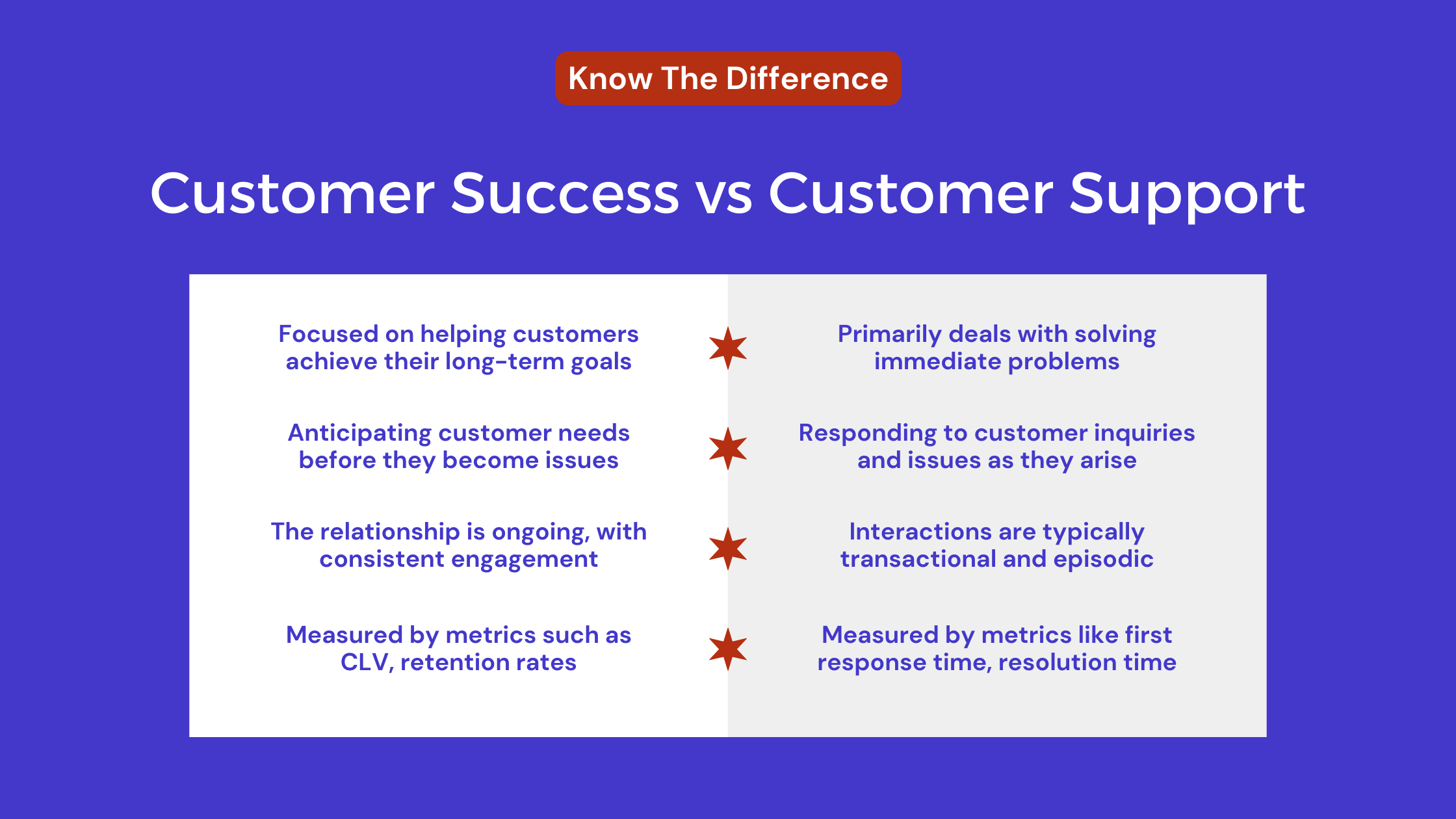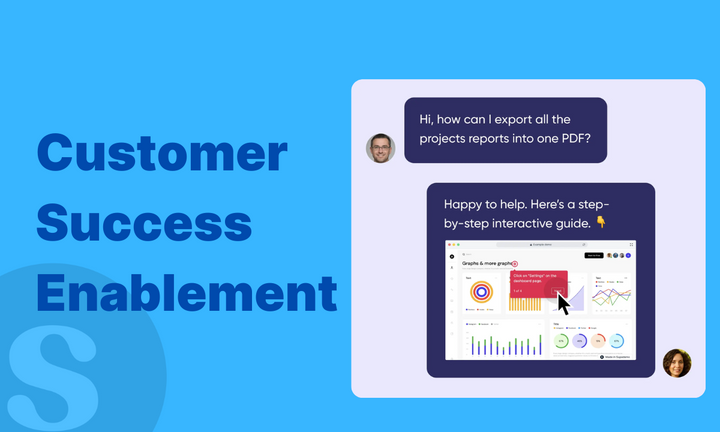In today's customer-centric marketplace, it's no longer sufficient to rely solely on sales and marketing efforts. Businesses are increasingly recognizing the importance of customer success in sustaining growth and thriving in a competitive landscape.
Table of Contents
- What is Customer Success?
- Customer Success vs. Customer Support
- Why Customer Success is Important
- The Role of a Customer Success Team
- Customer Success Strategies
- Implementing a Customer Success Strategy
- Customer Success Best Practices
- Measuring Customer Success
What is Customer Success?
Customer success is a strategic approach focused on ensuring that customers achieve their desired outcomes while using a product or service. It's about proactively guiding customers to find effective use of a product, thereby maximizing the value they receive. The ultimate aim is to foster a positive, long-term relationship, leading to customer retention and growth opportunities for both the customer and the company.
Customer Success vs. Customer Support
Customer success and customer support are two related but distinct functions within a business. While both aim to help customers, there are key differences in their approach and focus.

Customer Success
Customer success takes a proactive approach to ensure customers achieve their desired outcomes. It involves building strong relationships with customers, understanding their goals, and providing strategic guidance throughout their journey. Customer success is focused on helping customers maximize the value they derive from a product or service, ultimately driving their success and satisfaction.
Customer Support
Customer support, on the other hand, is primarily reactive and focuses on resolving customer issues or problems. It involves addressing customer inquiries, troubleshooting technical issues, and providing assistance when customers encounter difficulties. Customer support aims to provide timely and effective solutions to customer problems, ensuring their satisfaction and resolving any challenges they may face.
While customer success and customer support are distinct functions, they often work hand in hand to ensure a positive customer experience. Customer success teams provide proactive guidance and support, while customer support teams handle reactive inquiries and provide immediate assistance.
Why Customer Success is Important
Customer success is vital for the long-term success and sustainability of a business. It has a direct impact on customer satisfaction, retention, and revenue growth. Here are some key reasons why customer success matters:
1. Strengthening Customer Relationships
Customer success focuses on building strong relationships with customers. By understanding their goals, challenges, and needs, businesses can tailor their offerings and support to meet customer expectations. This personalized approach enhances the overall customer experience and strengthens the bond between the customer and the business.
2. Driving Customer Satisfaction and Loyalty
When customers achieve their goals and experience success with a product or service, they are more likely to be satisfied and loyal. Customer success helps businesses ensure that customers are not only happy with their initial purchase but also continue to derive value from the product or service over time. Satisfied and loyal customers are more likely to become brand advocates, refer others to the business, and contribute to its long-term success.
3. Increasing Customer Retention and Reducing Churn
Customer success plays a crucial role in reducing customer churn. By proactively helping customers succeed and addressing any challenges or issues they may face, businesses can improve customer retention rates. Retaining existing customers is often more cost-effective than acquiring new ones, making customer success an essential strategy for maximizing customer lifetime value.
4. Driving Revenue Growth
Successful customers are more likely to become repeat buyers and make additional purchases from the business. By ensuring customer success, businesses can increase upsell and cross-sell opportunities, driving additional revenue growth. Happy and satisfied customers are also more likely to provide positive reviews and referrals, attracting new customers and further contributing to revenue growth.
The Role of a Customer Success Team
A customer success team plays a critical role in driving customer success and ensuring customer satisfaction. The team is responsible for guiding customers throughout their journey, proactively addressing their needs, and helping them achieve their goals. Here are some key responsibilities of a customer success team:
1. Onboarding and Adoption
Customer success teams are responsible for ensuring a smooth onboarding process for new customers. They help customers understand how to use the product or service effectively, provide training and resources, and guide them toward successful adoption. This includes helping customers set up their accounts, understand key features, and navigate any initial challenges.
2. Relationship Building
Building strong relationships with customers is a key focus of customer success teams. They act as trusted advisors, understanding customers' unique needs and goals, and providing personalized guidance and support. Customer success managers maintain regular communication with customers, proactively addressing their concerns and providing ongoing assistance.
3. Value Delivery
Customer success teams play a crucial role in ensuring customers derive maximum value from a product or service. They help customers understand the full potential of the offering, identify opportunities for improvement, and provide recommendations on how to achieve their desired outcomes. By delivering value to customers, customer success teams contribute to long-term customer satisfaction and loyalty.
4. Retention and Renewals
Retaining existing customers is a primary objective of customer success teams. They work closely with customers to understand their needs and address any challenges or issues that may arise. By proactively addressing customer concerns and providing exceptional support, customer success teams increase customer retention rates and drive renewals.
5. Upselling and Cross-Selling
Customer success teams are well-positioned to identify upsell and cross-sell opportunities. They have a deep understanding of customers' needs and can recommend additional products or services that align with their goals. By leveraging existing customer relationships, customer success teams drive revenue growth through upselling and cross-selling efforts.
6. Customer Advocacy
Customer success teams serve as advocates for customers within the organization. They gather customer feedback, identify areas for improvement, and communicate customer needs to product, marketing, and sales teams. By representing the voice of the customer, customer success teams contribute to the continuous improvement of products and services.
Customer Success Strategies
Achieving customer success requires a strategic and proactive approach. Here are some key strategies to consider when aiming for customer success:
1. Personalized Onboarding
Invest in a personalized onboarding process that helps customers understand how to use the product or service effectively. Tailor the onboarding experience to each customer's unique needs and goals, providing training, resources, and support to ensure a smooth transition and successful adoption.
2. Proactive Communication and Engagement
Maintain regular communication with customers, proactively addressing their needs, challenges, and questions. Be proactive in providing guidance, recommendations, and support to help customers achieve their desired outcomes. Regular check-ins, progress assessments, and milestone celebrations can foster a sense of partnership and success.
3. Continuous Education and Training
Offer ongoing education and training opportunities to help customers stay up to date with the product or service. Provide resources, webinars, tutorials, and knowledge bases to empower customers and enable them to maximize the value they derive from the offering. Continuous learning ensures customers are equipped to succeed and adapt to new features or updates.
4. Data-Driven Insights and Recommendations
Utilize customer data and analytics to gain insights into customer behavior, usage patterns, and challenges. Leverage these insights to provide data-driven recommendations and guidance to customers. Identify opportunities for improvement, suggest best practices, and help customers optimize their use of the product or service.
5. Customer Community and Advocacy Programs
Create a customer community or advocacy program that fosters collaboration, knowledge sharing, and networking among customers. Encourage customers to connect with each other, share success stories, and provide peer-to-peer support. A strong customer community enhances the customer experience, builds loyalty, and promotes customer success.
6. Continuous Improvement and Feedback Loop
Establish a feedback loop with customers to gather insights, suggestions, and feedback on their experience with the product or service. Actively listen to customer feedback, respond to concerns, and implement improvements based on their input. Regularly review customer success metrics and adjust strategies and initiatives to drive continuous improvement.
Implementing a Customer Success Strategy
Implementing a customer success strategy is crucial for businesses aiming to prioritize customer success and drive long-term growth. Here are some key steps to consider when developing and implementing a customer success strategy:
1. Define Success Metrics
Before implementing a customer success strategy, it's important to define success metrics and key performance indicators (KPIs). These metrics will help measure the effectiveness of customer success efforts and track progress toward desired outcomes. Examples of success metrics include customer satisfaction scores, retention rates, renewal rates, and upsell/cross-sell revenue.
2. Understand Customer Needs
To develop a successful customer success strategy, businesses need to have a deep understanding of their customers' needs, goals, and pain points. Conducting customer research, gathering feedback, and analyzing customer data can provide valuable insights into customer preferences and challenges. This information will help tailor customer success efforts to meet specific customer needs.
3. Segment Customer Base
Segmenting the customer base is essential for effective customer success management. Customers have different needs, goals, and levels of engagement. By segmenting customers based on factors such as industry, product usage, or customer lifecycle stage, businesses can deliver personalized experiences and targeted support. This allows customer success teams to allocate resources efficiently and provide tailored guidance to each customer segment.
4. Develop Onboarding Processes
A well-designed onboarding process is critical for setting customers up for success. Develop a comprehensive onboarding program that helps customers understand the product or service, provides training and resources, and guides them toward achieving their goals. Regular check-ins and progress assessments can help identify any challenges early on and address them proactively.
5. Foster Collaboration Across Teams
Customer success is a cross-functional effort that requires collaboration across different teams within the organization. Sales, marketing, product, and support teams should work together to ensure a seamless customer experience. Regular communication, sharing of customer insights and feedback, and aligning strategies and goals will enable a cohesive approach to customer success.
6. Continuously Measure and Iterate
Customer success is an ongoing process that requires continuous measurement and iteration. Regularly review success metrics, gather customer feedback, and assess the effectiveness of customer success initiatives. Use this information to make data-driven improvements and refine the customer success strategy over time.
Customer Success Best Practices
To ensure effective customer success, it's important to follow best practices that align with your business goals and customer needs. Here are some customer success best practices to consider:
1. Customer-Centric Culture
Develop a customer-centric culture within your organization, emphasizing the importance of customer success and satisfaction. Ensure that all teams, from sales and marketing to product and support, are aligned and focused on delivering exceptional customer experiences. Foster a culture of collaboration, empathy, and continuous improvement.
2. Cross-Functional Collaboration
Encourage cross-functional collaboration among teams to provide a seamless customer experience. Foster open communication, share customer insights and feedback, and align strategies and goals to support customer success. Collaboration ensures that all customer touchpoints are consistent, effective, and aligned with customer expectations.
3. Clear Communication and Expectations
Establish clear communication channels and expectations with customers. Set realistic goals, explain the value proposition, and ensure customers understand what to expect from the product or service. Regularly communicate updates, enhancements, and improvements to keep customers informed and engaged.
4. Proactive Support and Issue Resolution
Take a proactive approach to support and issue resolution. Anticipate customer needs, identify potential challenges, and address them before they become major issues. Provide self-service resources, knowledge bases, and FAQs to empower customers and enable them to find answers on their own. When issues arise, respond promptly and provide effective solutions.
5. Continuous Learning and Development
Invest in the continuous learning and development of your customer success team. Equip them with the skills, knowledge, and tools they need to effectively guide customers towards success. Provide regular training, coaching, and educational resources to keep them updated on product updates, industry trends, and customer success best practices.
6. Celebrate Customer Success
Celebrate customer success and milestones to acknowledge and reinforce positive outcomes. Recognize and appreciate customers who have achieved their goals or milestones using your product or service. Highlight success stories, share customer testimonials, and create a culture of celebration and recognition.
Measuring Customer Success
Measuring customer success is crucial for understanding the impact of customer success initiatives and tracking progress toward desired outcomes. Here are some key metrics and indicators to consider when measuring customer success:
1. Customer Satisfaction
Customer satisfaction measures how satisfied customers are with the product, service, or overall experience. It can be assessed through customer surveys, feedback, and Net Promoter Score (NPS) ratings. High customer satisfaction scores indicate that customers are achieving their desired outcomes and are likely to remain loyal.
2. Retention Rate
Retention rate measures the percentage of customers who continue to use the product or service over a specific period. A high retention rate indicates that customers are finding value and success with the offering, while a low retention rate may signal dissatisfaction or unmet expectations.
3. Renewal Rate
Renewal rate measures the percentage of customers who renew their contracts or subscriptions. A high renewal rate indicates that customers are satisfied and see value in continuing their relationship with the business. It is a strong indicator of customer success and long-term customer loyalty.
4. Expansion Rate
Expansion rate measures the percentage of customers who upgrade or purchase additional products or services from the business. A high expansion rate suggests that customers are finding value and are willing to invest further in the relationship. It indicates successful customer outcomes and presents opportunities for revenue growth.
5. Time to Value
Time to value measures the period it takes for customers to achieve their desired outcomes and realize the full value of the product or service. A shorter time to value indicates effective onboarding, adoption, and support, leading to faster customer success and satisfaction.
6. Customer Health Score
A customer health score is a composite metric that combines various indicators of customer success, such as product usage, engagement, and satisfaction. It provides an overall assessment of the customer's health and likelihood of achieving their goals. Regular monitoring of customer health scores helps identify at-risk customers and provides insights for proactive interventions.
In essence, customer success is a comprehensive, proactive approach that not only addresses immediate customer needs but also anticipates future requirements, thereby nurturing a fruitful, long-term relationship between the customer and the business. This strategic focus is key to thriving in the modern, competitive marketplace.








